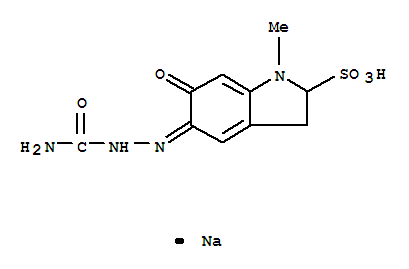
CasNo: 51460-26-5
Molecular Formula: C10H11N4NaO5S
Appearance: Orange yellow crystalline powder
|
Chemical Properties |
Carbazochrome sodium sulfonate is Yellow Solid |
|
Uses |
Carbazochrome sodium sulfonate is a Phosphatidylinositol hydrolysis inhibitor in endothelial cells. Carbazochrome sodium sulfonate, also known by the trade name "Hemostyl," is primarily used in the medical and pharmaceutical fields rather than in industrial applications. It is a medication known for its hemostatic properties and its ability to stabilize capillaries. Here's how it is used in the medical and pharmaceutical context: Treatment of Hemorrhage, Clinical Applications, Dosage Form, Mechanism of Action, Research and Clinical Studies. |
InChI:InChI=1/C10H12N4O5S.Na/c1-14-7-4-8(15)6(12-13-10(11)16)2-5(7)3-9(14)20(17,18)19;/h2,4,9H,3H2,1H3,(H3,11,13,16)(H,17,18,19);/q;+1/p-1/b12-6-;
We present findings from a group of HHT (Hereditary Hemorrhagic Telangiectasia) patients who exhibited a favorable response to treatment with carbazochrome-sodium-sulfonate, an older hemostatic drug known for its capillary-stabilizing properties, a use previously unexplored in such patients. Carbazochrome-sodium-sulfonate is typically employed in clinical settings to address hemorrhages arising from capillary fragility. Although its mechanism of action remains elusive, it is believed to potentially influence fibrinolysis by modulating endothelial cell function. Carbazochrome has been utilized for various purposes in managing bleeding disorders.
Subjects comprised 100 patients scheduled to undergo TKA, randomized into 2 groups: 50 patients received the drain-clamping method using tranexamic acid and carbazochrome sodium sulfonate hydrate and 50 patients received drain-clamping with saline. Although bleeding volume was significantly lower in the group with tranexamic acid and carbazochrome sodium sulfonate hydrate, risk of asymptomatic deep venous thrombosis as detected by ultrasonography was comparable between groups. Tranexamic acid and carbazochrome sodium sulfonate hydrate in the drain-clamping method help reduce bleeding after TKA without increasing the risk of deep venous thrombosis.